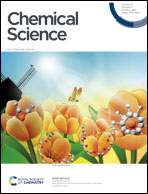Metal-free C(sp3)–H functionalization of sulfonamides via strain-release rearrangement†
Abstract
With the increasing awareness of sustainable chemistry principles, the development of an efficient and mild strategy for C(sp3)–H bond activation of nitrogen-containing compounds without the utilization of any oxidant and metal is still highly desired and challenging. Herein, we present a metal-free reaction system that enables C–H bond functionalization of aliphatic sulfonamides using DABCO as a promoter under mild conditions, affording a series of α,β-unsaturated imines in good yields with high selectivities. This protocol tolerates a broad range of functionalities and can serve as a powerful synthetic tool for the late-stage modification of complex compounds. More importantly, control experiments and detailed DFT calculations suggest that this process involves [2 + 2] cyclization/ring-cleavage reorganization, which opens up a new platform for the establishment of other related reorganization reactions.



 Please wait while we load your content...
Please wait while we load your content...